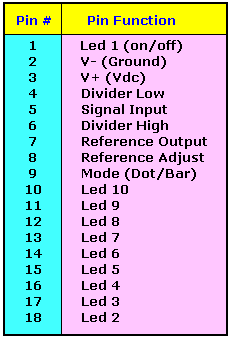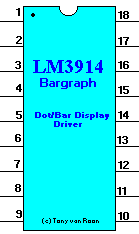LM3914 Dot/Bar Display Driver
Data sheet
Direct substitute(s): NTE1508, ECG1508
by Tony van Roon


Look at all these features:
o 18 pin Dual-In-Line (DIL) Integrated Circuit.
o Drives LEDs, LCDs or vacuum fluorescents
o Bar or Dot display mode externally selectable by user.
o Expandable to displays of 100 steps.
o Internal voltage reference from 1.2 to 12V.
o Operates on single supply of less than 3V.
o Supports 10 Led's, directly driven, all colors.
o 10-step DOT/BAR driver for linear scale.
o Only a couple of external components required.
o Works with voltages between 3 and 25Vcc.
o Inputs operate down to ground.
o Output current programmable from 2 mA to 30 mA.
o No multiplex switching or interaction between outputs.
o Input withstands approximately 35V without damage or false outputs.
o LED driver outputs are currents regulated, open collectors.
o Outputs can interface with TTL or CMOS logic.
o The internal 10-step divider is floating and can be referenced to a wide range of voltages.
The LM3914 is a monolithic integrated circuit that senses analog voltage levels and drives 10 Leds, providing a linear
anolog display. A single pin (9) changes the display from a moving dot to a bar graph. Current drive to the LEDs is
regulated and programmable, eliminating the need for resistors. This feature is one that allows operation of the whole
system from less than 3V.
The system contains its own adjustable reference and accuracte 10-step voltage divider. The low-bias-current input
buffer accepts signals down to ground, or V-, yet needs no protection against inputs of 35V above or below ground.
The buffer drives 10 individual comparators referenced to the precision divider. Indication non-linearity can thus
be held typically to 1/2%, even over a wide temperature range.
Versatility was designed into the LM3914 so that controller, visual alarm, and expanded scale funtions are easily added
on to the display system. The circuit can drive LEDs of many colors, or low-current incandescent lamps. Many LM3914's
can be "chained" to form displays of 20 to over 100 segments. Both ends of the voltage divider are externally available
so that 2 drivers can be made into a zero-center meter.
The LM3914 is very easy to apply as an analog meter circuit. A 1.2V full-scale meter requires only 1 resistor and a
single 3V to 15V supply in addition to the 10 display LEDs. If the 1 resistor is a pot, it becomes the LED brightness
control.
When in "DOT" mode, there is a small amount of overlap or "fade" (about 1mV) between segments. This assures that at no
time will all LEDs be "OFF", and thus any ambiguous display is avoided. Various novel displays are possible.
Much of the display flexibility derives from the fact that all outputs are individual, DC regulated currents. Various
effects can be achieved by modulating these currents. The individual outputs can drive a transistor as well as a LED
at the same time, so controller functions including "staging" control can be performed. The LM3914 can also act as a
programmer, or sequencer.
The LM3914 is rated for operation from 0°C to +70°C. The LM3914N is available in an 18-lead molded (N) package.
With pin 9 not connected (floating), it is functioning in 'DOT' mode. Meaning, it will light up one led at a time. If
you wish to use the 'BAR' mode, then connect pin 9 to the positive supply rail, but obviously with increased current
consumption. This chip is pretty versatile and can handle a lot of abuse, just don't exceed the manuafacturer's
voltage maximum.
If the leads of the LEDs are longer than 6 inches, a 10µF electrolytic capacitor is needed over the Anodes of the
LEDs and pin 2. A 2.2µF Tantalum capacitor can be used instead of the electrolytic.





